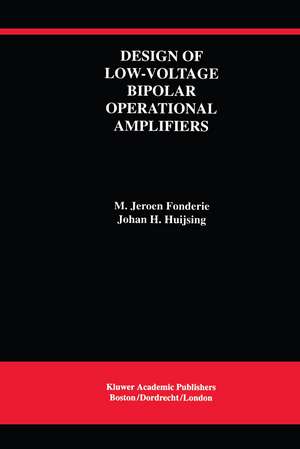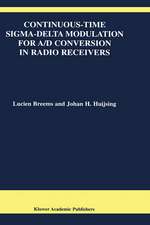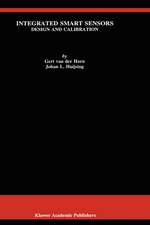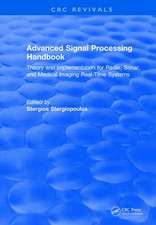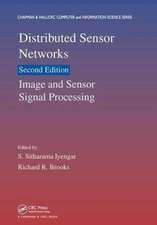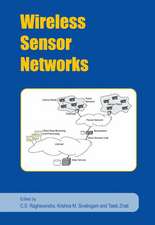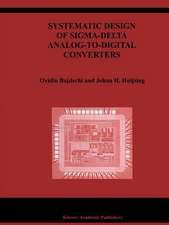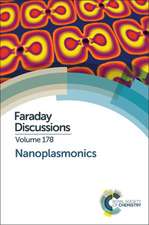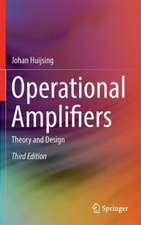Design of Low-Voltage Bipolar Operational Amplifiers: The Springer International Series in Engineering and Computer Science, cartea 218
Autor M. Jeroen Fonderie, Johan Huijsingen Limba Engleză Paperback – 22 dec 2012
The design and implementation of low-voltage bipolar Operational Amplifiers (OpAmps) is fully presented. A low supply voltage is necessary because the tendency towards chip components of smaller dimensions lowers the breakdown voltage of these components. Further, a low supply voltage is favorable because it enables operation of the OpAmp from just one single battery cell. The bipolar technology is chosen, because it is more suited for operation at low-voltages than the MOS technology.
The common-mode input voltage of the OpAmp must be able to have any value that fits within the supply voltage range. Input stages are discussed which are able to realize this at supply voltages down to 1.8 V, as well as down to 1 V.
The output voltage of the OpAmp must be able to have any value within the supply voltage range. One of the 1 V output stages that is discussed, the multi-path driven output stage, also has a high bandwidth with a high gain.
In addition to the input and output stage, the OpAmp comprises an intermediate stage, between the input stage and the output stage, to boost the overall gain of the OpAmp, and a class AB current control.
A frequency compensation technique is used to split apart the pole frequencies in the transfer function. A disadvantage of this nested Miller compensation, is that the resulting bandwidth is reduced by a factor of two. A new method, multi-path-driven Miller compensation, which does not have this drawback, is therefore introduced.
Several realizations are evaluated and a figure of merit is defined for the performance comparison of the OpAmps. One of the OpAmps operates at a 1 V supply, has a 3.4 MHz bandwidth with a 100 pF load and has a 700 &mgr;A supply current.
The book is an excellent reference for professional designers of amplifiers and may be used as a text for advanced courses on the subject.
| Toate formatele și edițiile | Preț | Express |
|---|---|---|
| Paperback (1) | 940.39 lei 6-8 săpt. | |
| Springer Us – 22 dec 2012 | 940.39 lei 6-8 săpt. | |
| Hardback (1) | 947.35 lei 6-8 săpt. | |
| Springer Us – 28 feb 1993 | 947.35 lei 6-8 săpt. |
Din seria The Springer International Series in Engineering and Computer Science
- 24%
 Preț: 1041.98 lei
Preț: 1041.98 lei - 20%
 Preț: 643.50 lei
Preț: 643.50 lei - 18%
 Preț: 1225.62 lei
Preț: 1225.62 lei - 18%
 Preț: 965.02 lei
Preț: 965.02 lei - 20%
 Preț: 646.12 lei
Preț: 646.12 lei - 18%
 Preț: 948.79 lei
Preț: 948.79 lei - 20%
 Preț: 646.62 lei
Preț: 646.62 lei - 15%
 Preț: 637.46 lei
Preț: 637.46 lei - 20%
 Preț: 643.83 lei
Preț: 643.83 lei - 18%
 Preț: 949.23 lei
Preț: 949.23 lei - 20%
 Preț: 644.48 lei
Preț: 644.48 lei - 20%
 Preț: 994.92 lei
Preț: 994.92 lei - 20%
 Preț: 645.97 lei
Preț: 645.97 lei - 18%
 Preț: 946.87 lei
Preț: 946.87 lei - 20%
 Preț: 995.57 lei
Preț: 995.57 lei - 18%
 Preț: 956.99 lei
Preț: 956.99 lei - 20%
 Preț: 644.98 lei
Preț: 644.98 lei - 15%
 Preț: 649.54 lei
Preț: 649.54 lei - 18%
 Preț: 950.21 lei
Preț: 950.21 lei - 18%
 Preț: 1221.38 lei
Preț: 1221.38 lei - 18%
 Preț: 957.62 lei
Preț: 957.62 lei - 15%
 Preț: 643.99 lei
Preț: 643.99 lei - 18%
 Preț: 948.47 lei
Preț: 948.47 lei - 18%
 Preț: 947.35 lei
Preț: 947.35 lei - 20%
 Preț: 1284.65 lei
Preț: 1284.65 lei - 20%
 Preț: 1628.31 lei
Preț: 1628.31 lei - 20%
 Preț: 1285.78 lei
Preț: 1285.78 lei
Preț: 940.39 lei
Preț vechi: 1146.82 lei
-18% Nou
Puncte Express: 1411
Preț estimativ în valută:
179.95€ • 192.42$ • 150.03£
179.95€ • 192.42$ • 150.03£
Carte tipărită la comandă
Livrare economică 17 aprilie-01 mai
Preluare comenzi: 021 569.72.76
Specificații
ISBN-13: 9781461363750
ISBN-10: 1461363756
Pagini: 208
Ilustrații: XI, 193 p.
Dimensiuni: 160 x 240 x 11 mm
Greutate: 0.3 kg
Ediția:Softcover reprint of the original 1st ed. 1993
Editura: Springer Us
Colecția Springer
Seria The Springer International Series in Engineering and Computer Science
Locul publicării:New York, NY, United States
ISBN-10: 1461363756
Pagini: 208
Ilustrații: XI, 193 p.
Dimensiuni: 160 x 240 x 11 mm
Greutate: 0.3 kg
Ediția:Softcover reprint of the original 1st ed. 1993
Editura: Springer Us
Colecția Springer
Seria The Springer International Series in Engineering and Computer Science
Locul publicării:New York, NY, United States
Public țintă
ResearchCuprins
1.1 Why Use a Low Supply Voltage?.- 1.2 Why Use Bipolar Technology?.- 1.3 Objectives of the Present Work.- 1.4 Design Considerations.- 1.5 Outline of This Book.- 1.6 References.- Input Stages.- 2.1 Complementary Input Stage.- 2.2 Complementary Input Stage with Constant Transconductance.- 2.3 Rail-To-Rail Input Stage at 1 Volt.- 2.4 Input Stage with Extended Input-Voltage Range.- 2.5 References.- Output Stages.- 3.1 Common-Emitter Output Stage.- 3.2 Darlington Output Stage.- 3.3 Widlar Output Stage.- 3.4 Multi-Path-Driven Output Stage.- 3.5 Parallel-Feedback Current Compensation.- 3.6 Conclusions.- 3.7 References.- Other Circuit Parts.- 4.1 Intermediate Stages.- 4.2 Class-AB Current Control-Circuits.- 4.3 Output-Saturation Protection.- 4.4 Output-Current Limiters.- 4.5 Bias Circuit.- 4.6 Conclusions.- 4.7 References.- Frequency Compensation.- 5.1 Simple Miller Compensation.- 5.2 Nested Miller Compensation.- 5.3 Multi-Path-Driven Miller Compensation.- 5.4 Slewing.- 5.5 Conclusions.- 5.6 References.- Realizations.- 6.1 2-V Opamp NE5234.- 6.2 1-V Opamp IS549.- 6.3 Opamps U2010 and U2011.- 6.4 1-V Opamp with 10-MHz Bandwidth.- 6.5 Conclusions.- 6.6 References.- Conclusions.- References.
